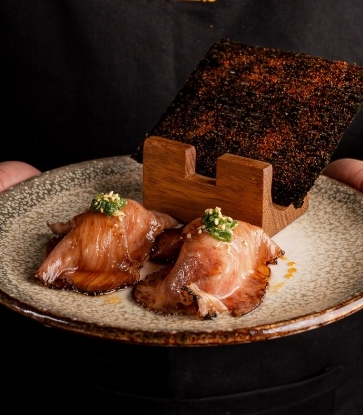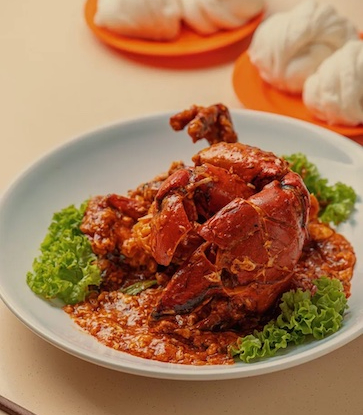Mexicans call it churro, Americans call it donut, Greeks call it loukoumades and Emiratis call it luqaimat. Across almost every cuisine, fried dough has been a staple dessert, reinterpreted and reimagined to adapt to individual cultures. Its universally loved by all, especially in the Middle East. Across the Gulf and Levantine regions, fried dough desserts are usually served in small bites and adorned with either powdered sugar, syrup, pomegranate molasses or chocolate.
Particularly in the United Arab Emirates, luqaimat, literally meaning ‘small bites’ in Arabic, has traditionally been a dessert significant to Ramadan and special occasions, and is particularly enjoyed with a cup of gahwa (Emirati coffee). Crunchy on the outside, glazed with date syrup and sprinkled with sesame seeds, soft and airy on the inside, this doughy ball of sweet goodness may be small in size, but having just one piece is near impossible.
Being a popular port for trade historically, the country has seen great influences from its surroundings, especially when it comes to their cuisine. Their centuries-old culinary heritage pays tribute to the many travellers and traders that journeyed through the United Arab Emirates during their travels.
READ MORE: The Emirati chai tea that everyone is drinking
If we were to go back in time, the dessert’s history is hard to trace. While some claim that its origins stem from Saudi Arabia, many also attribute its roots to 13th century medieval Iraq for similar desserts known as luqmat al qadi. Meaning the ‘judge’s morsels’, these puffed-up desserts were thought to sway a judge’s mind when in court. Since their early beginnings, they spread across the region and found their way to Turkey, Lebanon, Syria, India, Iran, and of course, the United Arab Emirates.

“Luqaimat is a cherished Emirati dessert, embodying the warmth and generosity of our culture,” explains Sohail Al Marzooqi, Director of MICHELIN-selected, Al-Fanar. “These golden, crispy doughnuts, soft and airy on the inside, are a testament to our rich culinary heritage,” he continues. Al Fanar’s menu is committed to keeping the traditional recipe alive and credits their “dedication to preserving Emirati culinary heritage” as the main reason to the uniqueness of the luqaimat served at the restaurant.
Al Marzooqi compares the Emirati dessert to the festive Dutch oliebollen and Italian zeppola and draws on his own childhood memories when he tried the dessert for the first time. “My first encounter with luqaimat was during a family Ramadan gathering in my childhood, an experience deeply ingrained in my memory,” he recalls, “it was in the cosy kitchen of my grandmother's house, where the aroma of freshly cooked luqaimat filled the air, marking festive occasions and gatherings with a taste of tradition and joy.”
As for chef Debi Prasad Rath of one MICHELIN star Emirati restaurant, Erth, his first memory of the doughy dessert is also one that made its mark. “The first time I tried luqaimat was during a trip to Dubai a few years ago,” he says, “I stumbled upon a local food market where they were freshly frying them, and I couldn't resist trying one.”
“The combination of crispy exterior and soft interior, along with the sweet honey drizzle, left a lasting impression on me.”
For the Indian chef, naturally, he compares to the delectable Indian dessert Gulab Jamun. “While there are differences in flavour profiles and ingredients between them, they share enough similarities in terms of texture, cooking method, and cultural significance to draw comparisons between the two desserts,” he says. “Both are delightful treats that evoke feelings of warmth, comfort, and celebration,” he goes on to say.
As for Erth’s version of the dessert, it’s cohesive with its menu overall. It promotes traditional flavours but plays on innovation. “Our luqaimat is a reflection of our commitment to quality, innovation, and the art of hospitality, ensuring that every visit to our restaurant is a truly unforgettable experience,” he explains.
READ MORE: The first ever Emirati restaurant to receive one MICHELIN star

As for the best way to eat it, both chef Debi and Sohail agree. “In the Emirati tradition, luqaimat are often enjoyed alongside a cup of Arabic coffee (gahwa),” chef Debi mentions. “The bitterness of the coffee contrasts beautifully with the sweetness of the luqaimat, creating a harmonious balance of flavours,” he continues, with Sohail adding that luqaimat “is best enjoyed fresh and warm, allowing the crisp exterior and soft interior to truly shine.”
The popular dessert is truly an homage to the country’s culinary history, multicultural tapestry, and festive celebrations in the region. It has managed to leave a lasting impression on locals, expats, and tourists alike. Thanks to its similarities to various desserts from multiple cuisines from around the world, it’s a dessert that entices warm memories for all those who try it.

















